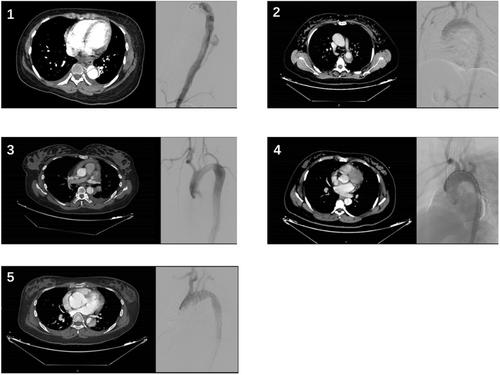Management and outcomes of aortic dissection type B in late pregnancy: A retrospective case series
Abstract
Objective
Pregnancy complicated with type B aortic dissection is a rare but devastating condition. Guidelines for managing this condition are lacking. We present our observation and experiences in managing five pregnant women with complicated type B aortic dissection in the second or third trimesters, aiming to gain insights that can aid in proposing an appropriate management strategy.
Design
A retrospective study.
Setting
Zhongnan Hospital of Wuhan University.
Population
Pregnant women with complicated type B aortic dissection.
Methods
Clinical data of five pregnant women with complicated type B aortic dissection admitted to Zhongnan Hospital of Wuhan University from January 2022 to June 2023 were collected. The clinical characteristics, treatment strategies, and corresponding maternal and infant outcomes were retrospectively analysed.
Main Outcome Measures
Survival of mothers and foetuses.
Results
All five study participants were diagnosed with complicated type B aortic dissection by computed tomography angiography (CTA). The range of gestational weeks at admission was 27 weeks + 3 days to 36 weeks + 6 days. The first patient, planning a caesarean section (C-section) followed by thoracic endovascular aortic repair (TEVAR), died of aortic dissection rupture during C-section. Her neonate was successfully rescued. In contrast, the remaining four patients who underwent TEVAR first survived. Among them, three patients underwent single-stage aortic repair and delivery, while one patient received C-section 31 days after TEVAR. Three preterm live births were recorded among these surviving mothers. Neonatal death occurred in one case with a gestational age of 29 weeks + 5 days, who had foetal distress before surgery. During the follow-up period of up to 3 months, no maternal or infant death occurred. No device-related or systemic complications were observed in the surviving mothers after discharge. Routine physical examinations of the four live births showed no abnormalities.
Conclusions
For pregnant women with thoracic back pain and high suspicion of aortic dissection, CTA should be conducted promptly to prevent missed or delayed diagnosis. Maternal survival should be prioritised over foetal outcome once diagnosed. TEVAR was demonstrated to be safe and feasible for such patients. For women with complicated type B aortic dissection in late pregnancy, TEVAR followed by C-section may be a promising treatment strategy.


 求助内容:
求助内容: 应助结果提醒方式:
应助结果提醒方式:


